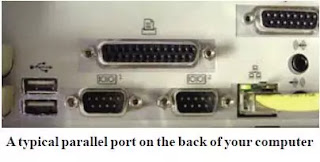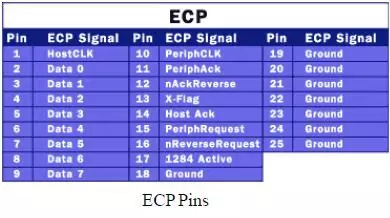Ports
The most basic communication ports in any PC system are the serial and
parallel ports. The serial ports were originally used for devices that has got to communicate bi-directional with the system. Such devices include modems, mice, scanners and the other devices that “ talk to” and receive information from the PC. Newer parallel interface standards now allow the parallel interface to perform highspeed bi-directional communications.
Serial ports :
Serial ports :
Considered to be one among the foremost basic external connections to a computer, the interface has been an integral a part of most computers for quite 20 years. Although many of the newer systems have done away with the interface completely in favor of USB connections, most modems still use the interface , as do some printers, PDAs and digital cameras. Few computers have quite two serial ports.
Essentially, serial ports provide a typical connector and protocol to allow you to attach devices, like modems, to your computer.
UART Needed :
All computer operating systems in use today support serial ports, because serial ports are around for many years . Parallel ports are a newer invention and are much faster than serial ports. USB ports are only a couple of years old, and can likely replace both serial and parallel ports completely over subsequent several years.
The name “serial” comes from the very fact that a interface “serializes” data. That is, it takes a byte of knowledge and transmits the 8 bits within the byte one at a time. The advantage is that a interface needs just one wire to transmit the 8 bits (while a parallel interface needs 8). The disadvantage is that it takes 8 times longer to transmit the info than it might if there have been 8 wires. Serial ports lower cable costs and make cables smaller.
Before each byte of knowledge , a interface sends a start bit, which may be a single bit with a worth of 0. After each byte of knowledge , it sends a stop bit to signal that the byte is complete. it's going to also send a parity .
Before each byte of knowledge , a interface sends a start bit, which may be a single bit with a worth of 0. After each byte of knowledge , it sends a stop bit to signal that the byte is complete. it's going to also send a parity .
Serial
ports, also called communication (COM) ports, are bi-directional.
Bidirectional communication allows each device to receive data also as transmit it. Serial devices use different pins to receive and transmit data — using an equivalent
pins would limit communication to half-duplex, meaning that information
could only travel in one direction at a time. Using different pins
allows for full-duplex communication, during which information can travel in both directions directly .
Serial ports believe a special controller chip, the Universal Asynchronous Receiver/Transmitter (UART), to function properly. The UART chip takes the parallel output of the computer’s system bus and transforms it into serial form for transmission through the interface . so as to function faster, most UART chips have a built-in buffer of anywhere from 16 to 64 kilobytes. This buffer allows the chip to cache data coming in from the system bus while it's processing data going bent the interface . While most traditional serial ports have a maximum transfer rate of 115 Kbps (kilobits per second), high speed serial ports, like Enhanced Serial Port (ESP) and Super Enhanced Serial Port (Super ESP), can reach data transfer rates of 460 Kbps.
The Serial Connection :
The external connector for a interface are often either 9 pins or 25 pins. Originally, the first use of a interface was to attach a modem to your computer. The pin assignments reflect that. Let’s take a better check out what happens at each pin when a modem is connected.
9-pin connector :
- Carrier Detect - Determines if the modem is connected to a working telephone line .
- Receive Data - Computer receives information sent from the modem.
- Transmit Data - Computer sends information to the modem.
- Data Terminal Ready - Computer tells the modem that it's able to talk
- Signal Ground - Pin is grounded.
- Data Set Ready - Modem tells the pc that it's able to talk.
- Request To Send - Computer asks the modem if it can send information.
- Clear To Send - Modem tells the pc that it can send information.
- Ring Indicator - Once a call has been placed, computer acknowledges signal (sent from modem) that a hoop is detected.
- 25- Pin connector:
- Not Used
- Transmit Data - Computer sends information to the modem.
- Receive Data - Computer receives information sent from the modem.
- Request To Send - Computer asks the modem if it can send information.
- Clear To Send - Modem tells the pc that it can send information.
- Data Set Ready - Modem tells the pc that it's able to talk.
- Signal Ground - Pin is grounded.
- Received Line Signal Detector - Determines if the modem is connected to a working telephone line.
- Not Used: Transmit Current Loop Return (+)
- Not Used
- Not Used: Transmit Current Loop Data (-)
- Not Used
- Not Used
- Not Used
- Not Used
- Not Used
- Not Used
- Not Used: Receive Current Loop Data (+)
- Not Used
- Data Terminal Ready - Computer tells the modem that it's able to talk.
- Not Used
- Ring Indicator - Once a call has been placed, computer acknowledges signal (sent from modem) that a hoop is detected.
- Not Used
- Not Used
- Not Used: Receive Current Loop Return (-)
Voltage sent over the pins are often in one among two states, On or Off. On (binary value “1”) means the pin is transmitting a sign between -3 and -25 volts, while Off (binary value “0”) means it's transmitting a sign between +3 and +25 volts...
Parallel ports :
If you've got a printer connected to your computer, there's an honest chance that it uses the parallel interface . While USB is becoming increasingly popular, the parallel interface remains a commonly used interface for printers.
Parallel ports are often wont to connect a number of popular computer peripherals :
- Printers
- Scanners
- CD burners
- External hard drives
- Iomega Zip removable drives
- Network adapters
- Tape backup drives
Parallel
Port Basics
Parallel ports were originally developed by IBM as how to attach a printer to your PC. When IBM was within the process of designing the PC, the corporate wanted the pc to figure with printers offered by Centronics, a top printer manufacturer at the time. IBM decided to not use an equivalent port interface on the pc that Centronics used on the printer.
Instead, IBM engineers coupled a 25-pin connector, DB-25, with a 36-pin Centronics connector to make a special cable to attach the printer to the pc . Other printer manufacturers ended up adopting the Centronics interface, making this strange hybrid cable an unlikely de facto standard. When a PC sends data to a printer or other device employing a parallel interface , it sends 8 bits of knowledge (1 byte) at a time. These 8 bits are transmitted parallel to every other, as against an equivalent eight bits being transmitted serially (all during a single row) through a interface . the quality parallel interface is capable of sending 50 to 100 kilobytes of knowledge per second.
Instead, IBM engineers coupled a 25-pin connector, DB-25, with a 36-pin Centronics connector to make a special cable to attach the printer to the pc . Other printer manufacturers ended up adopting the Centronics interface, making this strange hybrid cable an unlikely de facto standard. When a PC sends data to a printer or other device employing a parallel interface , it sends 8 bits of knowledge (1 byte) at a time. These 8 bits are transmitted parallel to every other, as against an equivalent eight bits being transmitted serially (all during a single row) through a interface . the quality parallel interface is capable of sending 50 to 100 kilobytes of knowledge per second.
SPP/EPP/ECP :
The original specification for parallel ports was unidirectional, meaning that data only traveled in one direction for every pin. With the introduction of the PS/2 in 1987, IBM offered a replacement bidirectional parallel interface design. This mode is usually referred to as Standard parallel interface (SPP) and has completely replaced the first design. Bidirectional communication allows each device to receive data also as transmit it. Many devices use the eight pins (2 through 9) originally designated for data. Using an equivalent eight pins limits communication to half-duplex, meaning that information can only travel in one direction at a time. But pins 18 through 25, originally just used as grounds, are often used as data pins also. this enables for full-duplex (both directions at an equivalent time) communication.
Enhanced Parallel Port interface (EPP) was created by Intel, Xircom and Zenith in 1991. EPP allows for far more data, 500 kilobytes to 2 megabytes, to be transferred each second. it had been targeted specifically for non-printer devices that might attach to the parallel interface , particularly storage devices that needed the very best possible transfer rate.
Close on the heels of the introduction of EPP, Microsoft and Hewlett Packard jointly announced a specification called Extended Capabilities Port (ECP) in 1992. While EPP was geared toward other devices, ECP was designed to supply improved speed and functionality for printers.
In 1994, the IEEE 1284 standard was released. It included the 2 specifications for parallel interface devices, EPP and ECP. so as for them to figure , both the OS and therefore the device must support the specified specification. this is often seldom a drag today since most computers support SPP, ECP and EPP and can detect which mode must be used, counting on the attached device. If you would like to manually select a mode, you'll do so through the BIOS on most computers.










0 Comments
I will be there for your help...